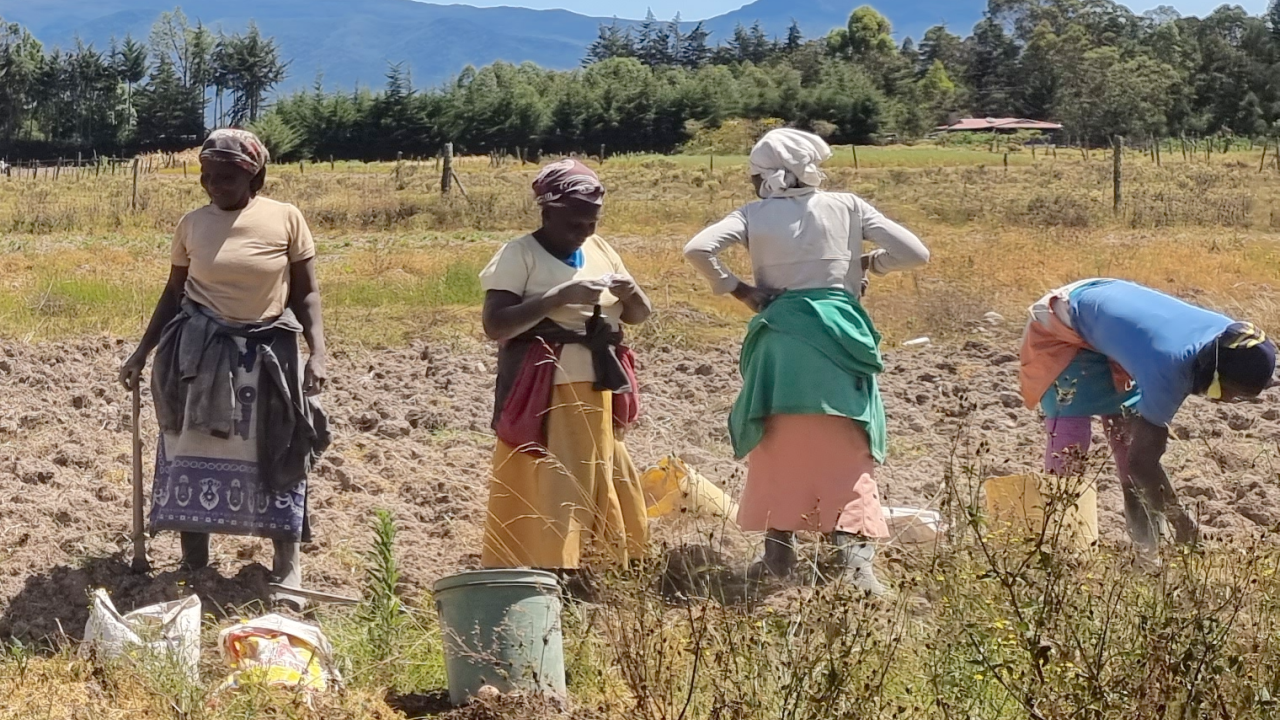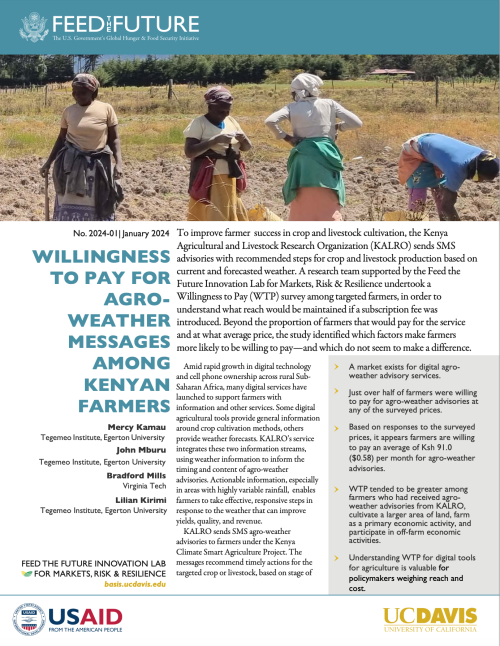
To improve farmer success in crop and livestock cultivation, the Kenya Agricultural and Livestock Research Organization (KALRO) sends SMS advisories with recommended steps for crop and livestock production based on current and forecasted weather. A research team supported by the Feed the Future Innovation Lab for Markets, Risk & Resilience undertook a Willingness to Pay (WTP) survey among targeted farmers, in order to understand what reach would be maintained if a subscription fee was introduced. Beyond the proportion of farmers that would pay for the service and at what average price, the study identified which factors make farmers more likely to be willing to pay—and which do not seem to make a difference.
Amid rapid growth in digital technology and cell phone ownership across rural Sub-Saharan Africa, many digital services have launched to support farmers with information and other services. Some digital agricultural tools provide general information around crop cultivation methods, others provide weather forecasts. KALRO's service integrates these two information streams, using weather information to inform the timing and content of agro-weather advisories. Actionable information, especially in areas with highly variable rainfall, enables farmers to take effective, responsive steps in response to the weather that can improve yields, quality, and revenue.
Highlights
- A market exists for digital agro-weather advisory services.
- Just over half of farmers were willing to pay for agro-weather advisories at any of the surveyed prices.
- Based on responses to the surveyed prices, it appears farmers are willing to pay an average of Ksh 91.0 ($0.58) per month for agro-weather advisories.
- WTP tended to be greater among farmers who had received agro-weather advisories from KALRO, cultivate a larger area of land, farm as a primary economic activity, and participate in off-farm economic activities.
- Understanding WTP for digital tools for agriculture is valuable for policymakers weighing reach and cost.
KALRO sends SMS agro-weather advisories to farmers under the Kenya Climate Smart Agriculture Project. The messages recommend timely actions for the targeted crop or livestock, based on stage of growth and current and forecasted weather. Farmers receive 2-4 messages per month in their preferred language.
Looking forward, the Government of Kenya must decide whether to maximize reach through continued free provision of agro-weather advisory services or pursue cost recovery for the program.
With funding from the Feed the Future Innovation Lab on Markets, Risk and Resilience, a Kenya-based research team collected WTP data in order to offer insights around how much revenue—and customer attrition—could be expected at different price points.
Contingent Valuation
The team sought to target recipients of KALRO agro-weather advisories with their survey. The survey was conducted after KALRO had sent agro-weather advisories for one full cropping season, and had commenced advisories for the following season. However, only 37% of the 2,384 respondents indicated they had received the messages.
Respondents were asked to consider a hypothetical agro-weather advisory service that would provide guidance on management practices during the growth stages of their crop or livestock, based on the temperature and rainfall in their locality. Farmers’ WTP was measured through a contingent valuation method. They first stated whether they would be willing to pay an initial price. Then, they were asked about a second price—higher if they were willing to pay the initial price, lower if they were not.
Willingness to Pay
The average price farmers in the study are willing to pay for agro-weather advisories is Ksh 91.0 ($.58) per month, or Ksh 364 per season. Among respondents, 49% indicated unwillingness to pay for the advisories at any of the surveyed prices.
WTP did not vary by gender or education level, nor did engagement with agricultural and financial markets have an effect. Factors that did increase WTP included: having received the agro-weather advisories from KALRO, cultivating a larger area, farming serving as a primary economic activity in the household, and participating in off-farm livelihood activities.

Costs and Sustainability
Were KALRO to start charging a subscription at the average WTP rate of Ksh 91.0, and farmers purchased according to their stated willingness, the costs of the agro-weather service would be covered. However, many smallholder farmers would be excluded from the service and miss opportunities to improve their production.
Price segmentation is an option that KALRO could consider in attempt to balance some cost recovery with higher reach. Acreage under cultivation would be the obvious factor along which to segment, as the survey showed WTP tended to increase with the quantity of land under cultivation. However, the costs involved in administering a complex pricing structure would have to be carefully considered—especially if it included verification of details like land holdings.
Global Applicability
Understanding farmer WTP for digital agricultural tools is valuable as the landscape of offerings grows and donors and investors consider their strategy. This study of KALRO's service yielded data consistent with a 2022 global survey that found approximately 50% of farmers were unwilling to pay for digital agricultural tools at any price.1
With cost as a known barrier to adoption, developers, policymakers, and investors can benefit from deeper insights. Further exploration is needed on the dissonance between proponents and intended users around the value of digital agricultural tools. While proponents see significant potential to improve farmers’ production and revenue, does farmers’ reluctance to pay indicate that these tools’ value is overestimated? Or do farmers' views stem from a lack of understanding or trust, or an expectation that such tools should be free?
While WTP analysis alone cannot answer these questions, it offers a valuable method to quantify the value that farmers place on a given digital service. This information, whether standalone or accompanied by additional research, can inform decision making around what tools to develop and how to fund them.
- 1Fiocco, D., Ganesan, V., de la Serrana Lozano, M.G., and Sharifi, H. “Agtech: Breaking down the farmer adoption dilemma,” McKinsey & Company, 7 February 2023.
